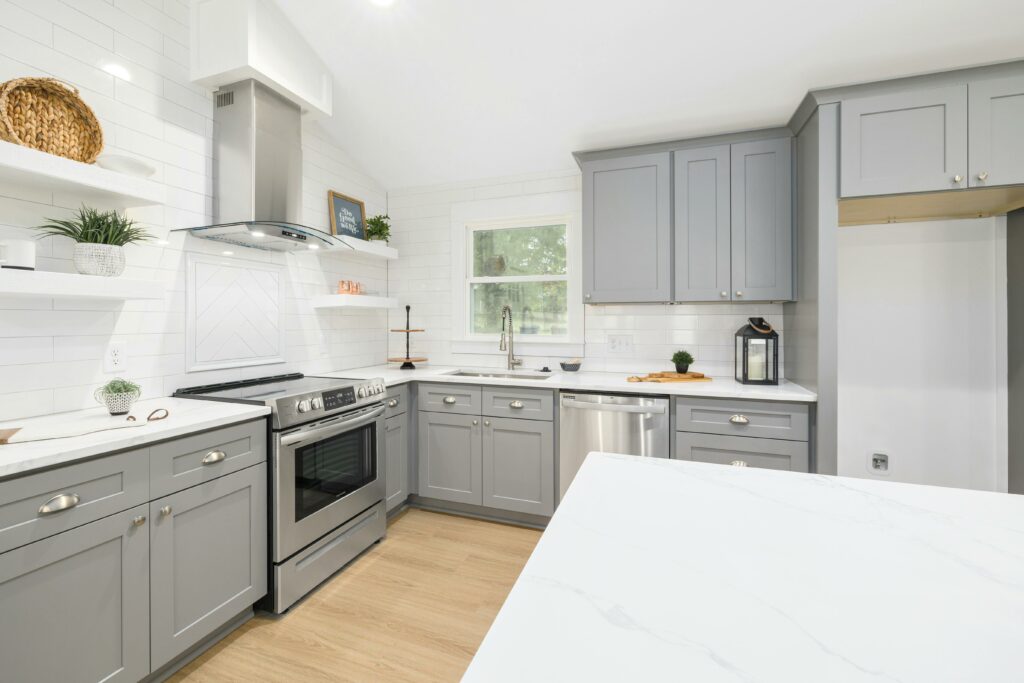
The addition of molding and trim can significantly improve the visual appeal of your cabinetry. These decorative accents give your cabinets a feeling of refinement, artistry, and individuality, transforming a plain kitchen, bathroom, or storage area into a breathtaking focal point. Molding and trim offer countless customizing options, whether you’re trying to update an outdated cabinet design or add a unique touch to a brand-new installation.
Askin Cabinets specializes in the design, production, and installation of cabinets that not only fulfill practical requirements but also improve your room’s aesthetic appeal. We will check out how molding and trim may give your cabinets personality and how our experience guarantees a smooth, gorgeous makeover.
Types of Molding for Cabinets
Understanding the many kinds of molding that are accessible is crucial before beginning the procedure. You may design an appearance that best suits the character of your house with each style’s unique effect.
- Crown Molding
Crown molding, one of the most popular styles, is utilized where the cabinet and ceiling meet. It gives cabinets more height and style, especially in rooms with higher ceilings. Crown molding provides a polished, unified appearance by drawing attention upward. The complex to elegant style of the molding makes it suitable for both modern and traditional interiors.
- Light Rail Molding
Usually, light rail molding is fitted beneath top cabinetry. Its main purpose is to hide under-cabinet lights, but it also has aesthetic value. It does more than just conceal light sources and it also provides the undersides of cabinets a smooth, polished look.
- Base Molding
Like baseboards in a room, base molding is put to the bottom of cabinets. It shields the edges from scratches and scuffs, helping to integrate cabinets into the general style of the space. This style of molding is excellent for creating a polished, built-in appearance in your bathroom or kitchen.
- Panel Molding
Cabinet door insets are framed with panel molding, which gives depth and character to the space. It’s particularly well-liked for shaker-style cabinets, which give them a more ornate or historic appearance. You may add visual appeal to the design without going overboard with this molding.
- Edge Molding
Applying edge molding to the edges of doors and drawers is a great way to add a personalized touch. Although it is small, this tiny element adds a level of elegance and expertise.
Benefits of Adding Molding and Trim
Decorative molding and trim have many useful benefits that can improve the look and feel of your cabinets in addition to their aesthetic value.
- Enhanced Visual Appeal
Molding gives your cabinets an instant design upgrade. Decorative accents, whether they are basic linear trimmings or detailed carvings, add a level of refinement and skill that plain cabinets would not have.
- Customization
No two cabinet designs have to be alike when it comes to molding and trim. You can adjust the style to fit the general design of your house. It is possible to personalize molding to fit the desired aesthetic for any type of area, be it rustic, modern, or classic.
- Enhanced Resale Value
Rich, well-designed cabinets can add a substantial amount of value to your house when it comes time to sell. Thoughtful design components like molding are frequently valued by buyers since they are regarded as indicators of fine craftsmanship and meticulous attention to detail.
- Cohesive Design Flow
By adding molding, you can better coordinate the architectural design of your room with your cabinets. Whether you tie in baseboards that match or create crown molding on your walls, this method offers the entire design a more cohesive, seamless appearance.
Design Considerations When Adding Molding
While molding and trim can completely change the appearance of your cabinets, you must pay close attention to the design details to make sure the finished product is what you had in mind.
- Proportion
It’s important to choose molding that complements the size of the space and your cabinets. Minimalist molding may be lost in bigger areas, while overly huge or complex moldings can overpower smaller kitchens. Askin Cabinets helps you choose the appropriate scale for your project so that the design is coherent and balanced.
- Style Consistency
When selecting molding and trim, take your home’s architectural style into account. Choose molding with basic, clear lines for a modern, minimalistic house. On the other hand, more elaborate and complex molding may be beneficial for homes with classic or Victorian design aspects.
- Color and Finish
Although they shouldn’t exactly match your cabinets, molding, and trim should still look good with them. While some homeowners like a uniform appearance, others decide to paint the molding in a contrasting color for a striking effect. To get the look you want, you can also experiment with other finishes like glossy, matte, or distressed.
- Material
The longevity and appearance of the cabinetry are significantly influenced by the material you select for your molding and trim. Wood is a popular choice because of its adaptability, but places that are exposed to moisture, such as kitchens or bathrooms, might be more suited for MDF (medium-density fiberboard) or PVC.
Leave The Molding and Trim to us At Askin Cabinets!
The use of molding and trim can significantly improve the visual appeal and functional utility of your cabinets. These components offer the ideal final touch, regardless of whether you’re going for a more elaborate and classic design or a modern, minimalist aesthetic. At Askin Cabinets, we’re committed to working with you to make your cabinets a focal point that complements your home’s overall design. Speak with our knowledgeable staff right now to learn more about your possibilities for using trim and molding to add character.
